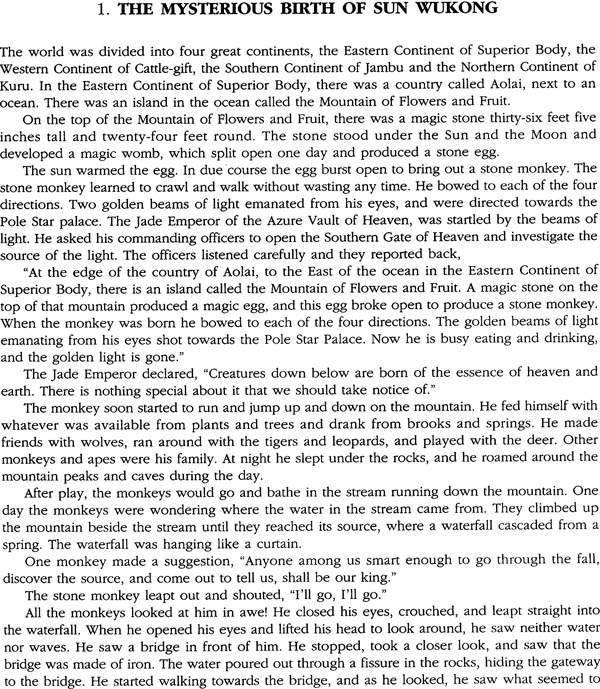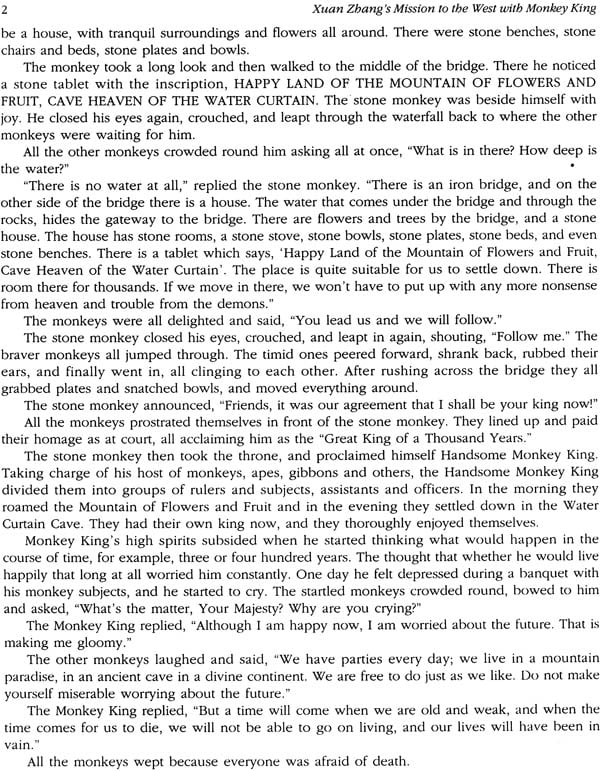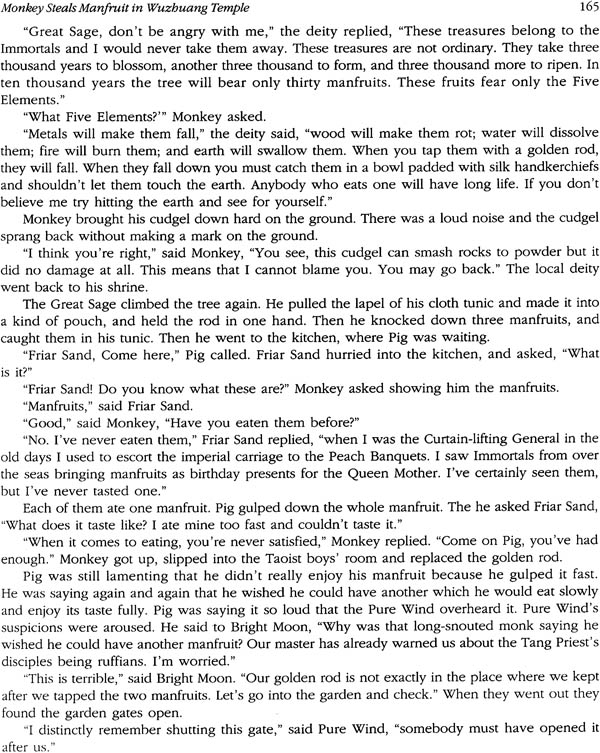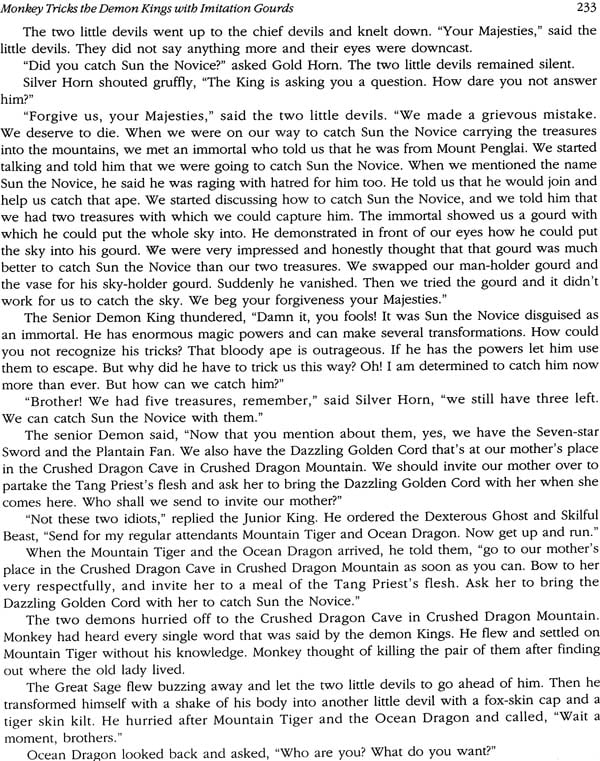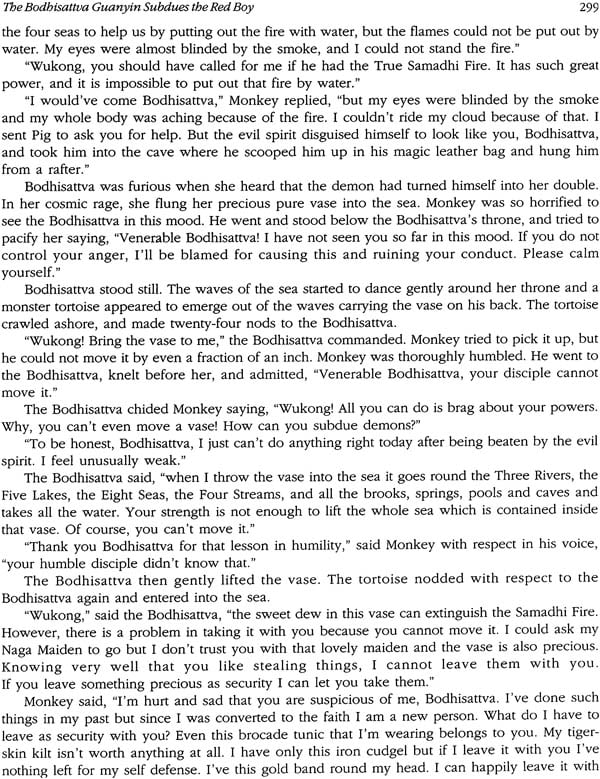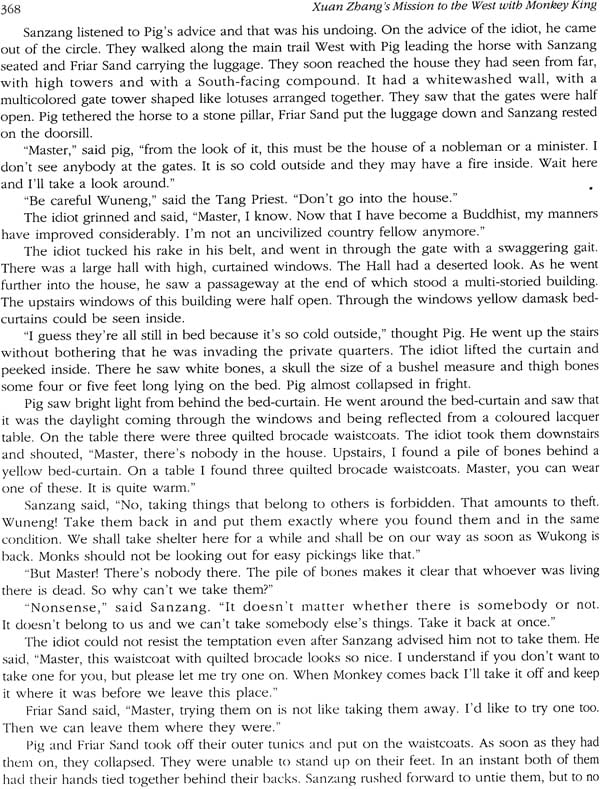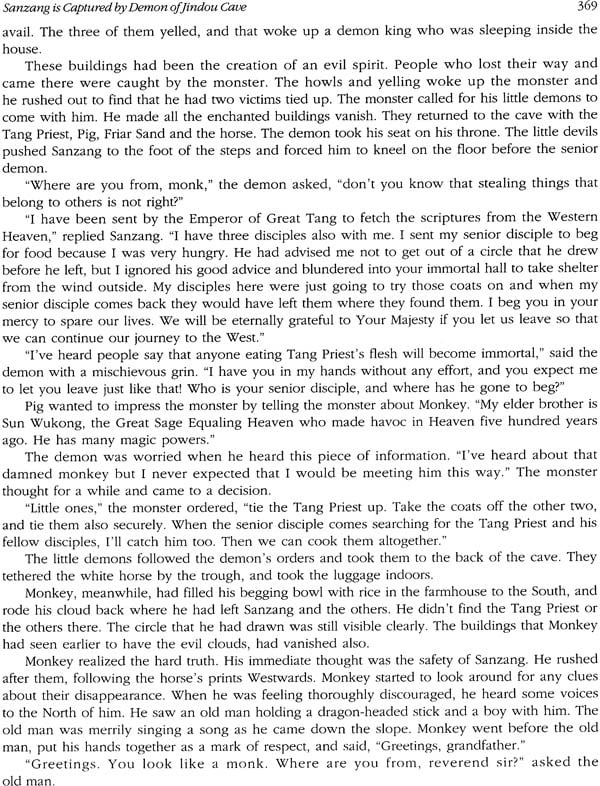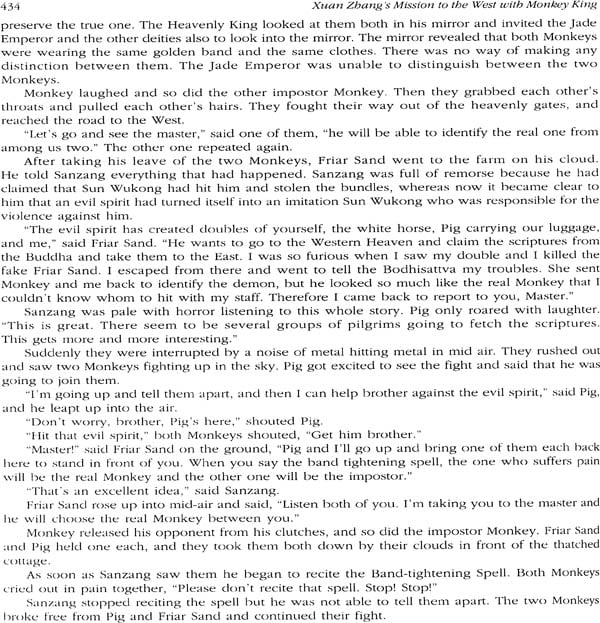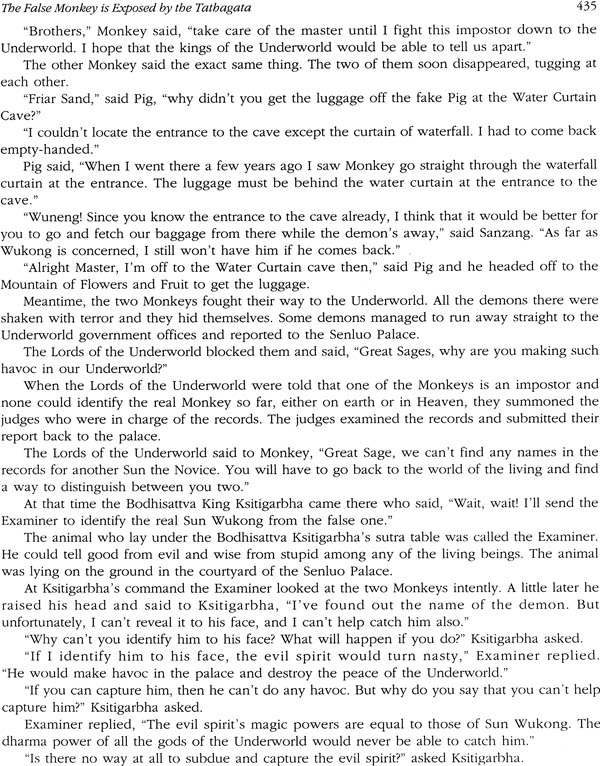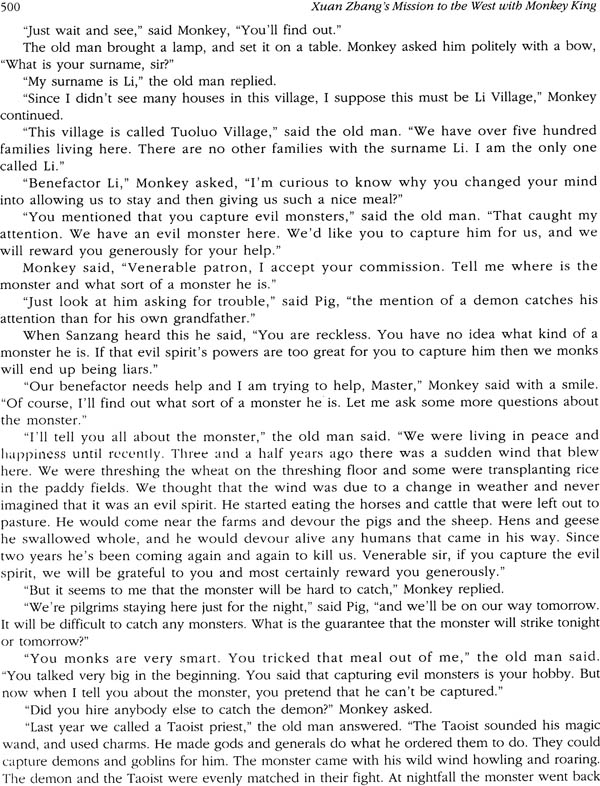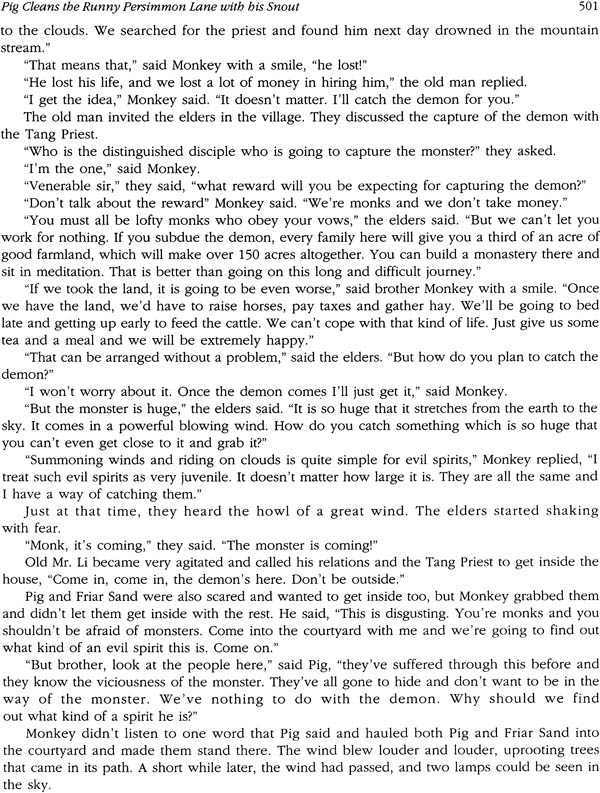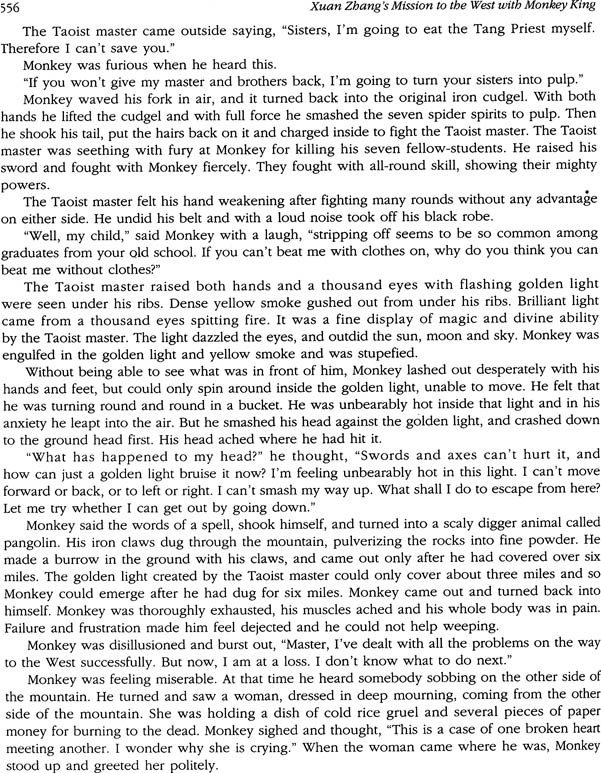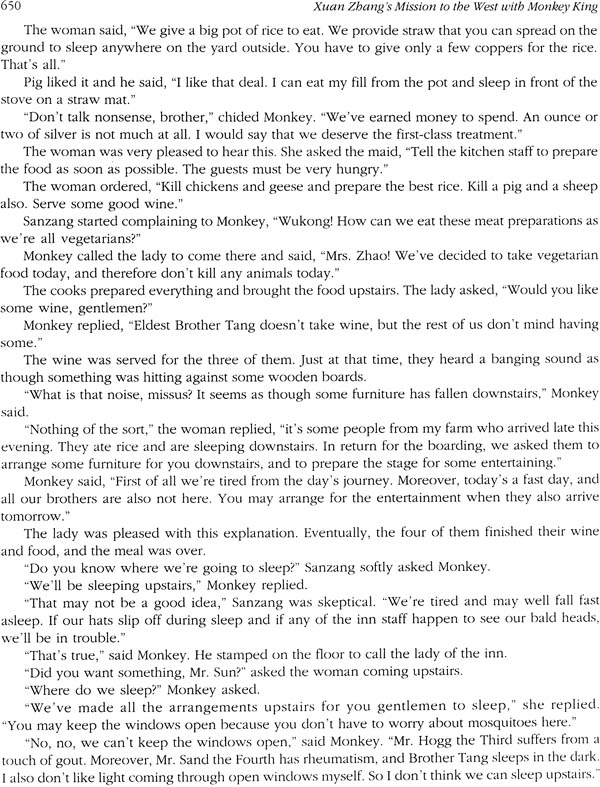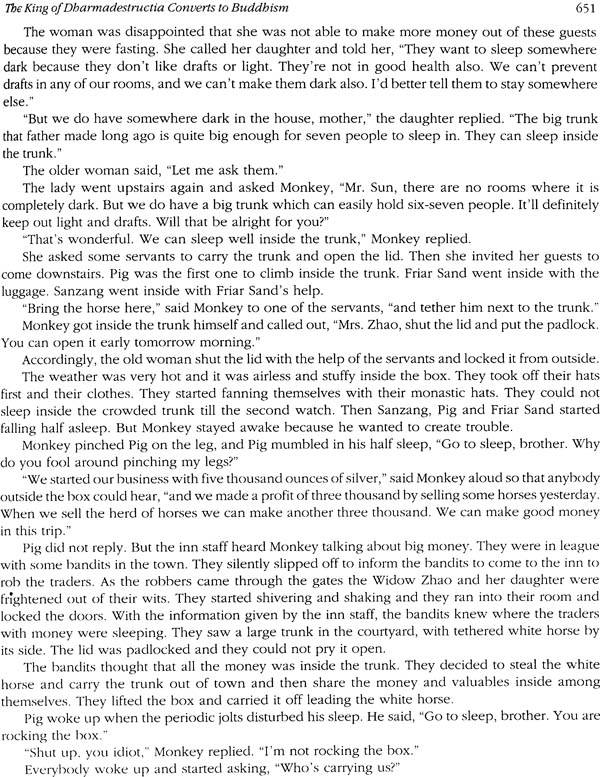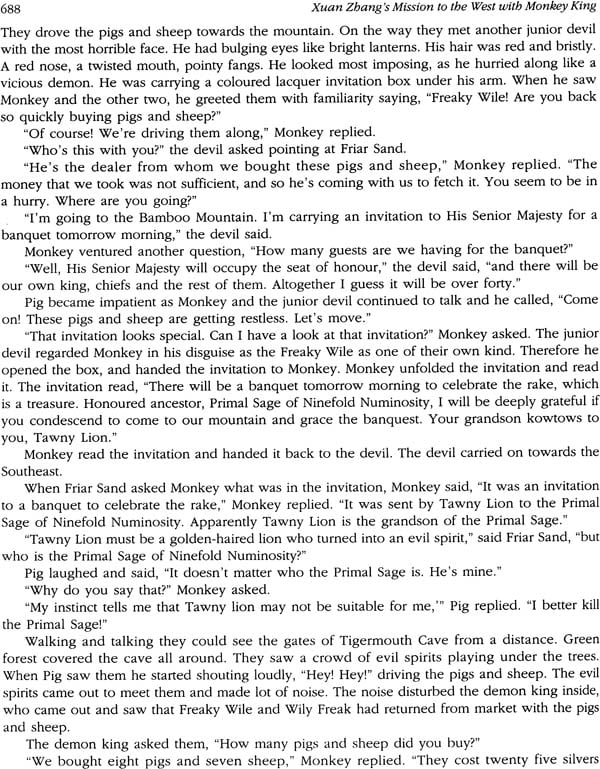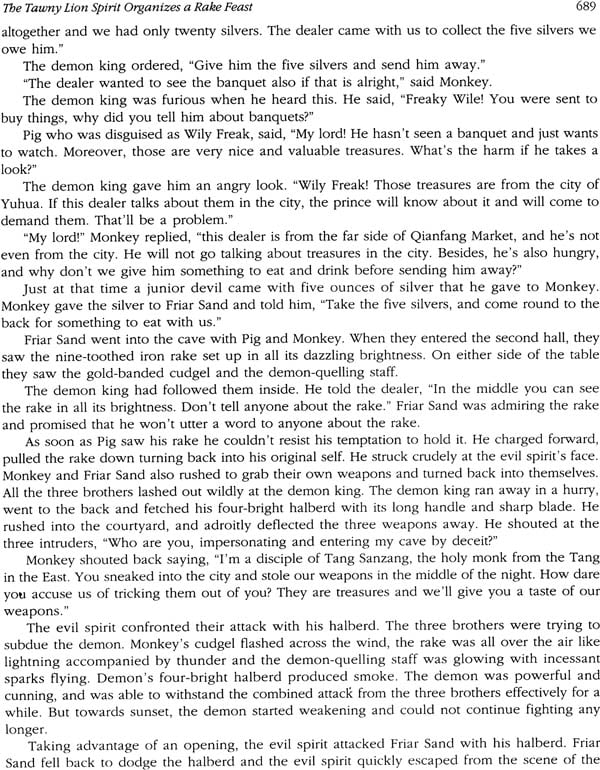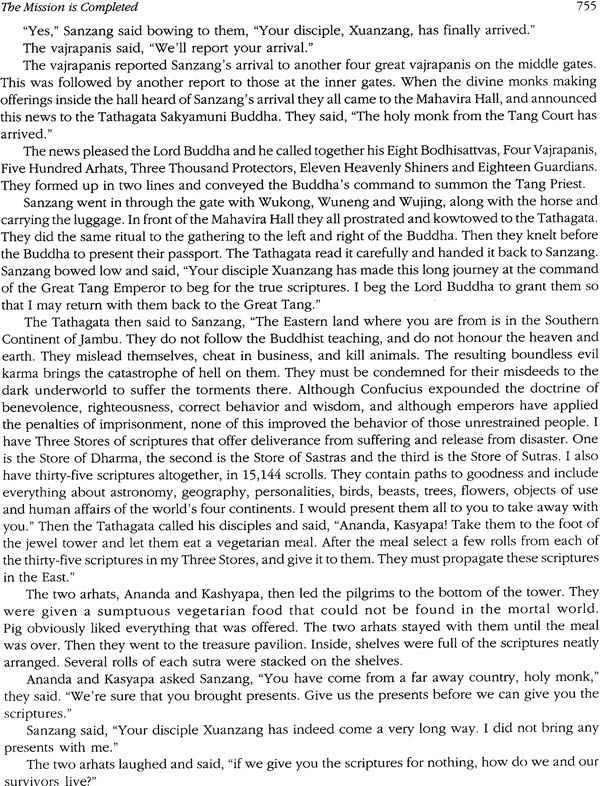
Xuan Zhang's Mission to the West with Monkey King
Book Specification
| Item Code: | NAM510 |
| Author: | Rama B. Bhat |
| Publisher: | Aditya Prakashan |
| Language: | English |
| Edition: | 2014 |
| ISBN: | 9788177421330 |
| Pages: | 783 |
| Cover: | Hardcover |
| Other Details | 11.5 inch X 8.5 inch |
| Weight | 2 kg |
Book Description
A monkey was conceived inside a huge stone egg. He found a teacher who taught the Monkey King the "72 transformations" with which he could change his shape and size at will. Monkey acquired the powers of cloud travelling, on a special somersault cloud using which he could travel on earth and Heaven with incredible speed. The teacher gave him the name Sun Wukong, which meant monkey who is aware of his emptiness.
Sun Wukong became arrogant and defied Heaven and Hell. The Jade Emperor appealed to the Buddha who kept Sun Wukong imprisoned under the Five Elements Mountain and Sun Wukon remained there for five hundred years.
Five hundred years thereafter, baby Xuan Zhang was born in captivity, and his mother put him in a boat and let it float down the river. The baby was rescued by the Chief Priest of a Buddhist Monastery down the river. Xuan Zhang acquired mastery in Buddhist scriptures.
King Taizong had to spend a brief time in Hell where he witnessed the suffering of the souls who were wrongfully sent to Hell. Taizong decided to perform a "Great Mass" to free all those souls upon his return to earth. He recruited Xuan Zhang to perform the Great Mass.
Bodhisattva Guanyin told Emperor Taizong to commission somebody to fetch the true scriptures from the West, i.e. from India. Emperor Taizong recruited Master Xuan Zhang to the task. Xuan Zhang was accompanied by Sun Wukong, the Pig or Zhu Bajie, and the demon of the Flowing Sands River, Sha Wujing, on this epic journey. The encounter countless demons and spirits who impeded their mission. Finally they accomplished their mission and returned safely to China with the scriptures.
The story has many similarities with Indian epics Ramayana and Mahabharata. This inspired the author to rewrite the story pointing out the similarities with Indian epics. The Original story is in Chinese and the English translation by Arthur Waley has been taken as the main reference for this narration, although other references mentioned in the References sections have been of great help.
About the Author
Rama Bhat is a Professor of Mechanical and Industrial Engineering at Concordia University, Montreal, Quebec, Canada. He served as the Chair of the department, Associate Dean in the Faculty and Vice Provost in the University. In addition to research on Vibrations and Acoustics, teaching and supervision of graduate student research, he has published 3 text books in engineering, and is a published poet in Kannada, an Indian language.
He wrote a book on "Divine Anjaneya" in order to introduce Anjaneya to the Chinese people. It is the author's intention to introduce the character of Sun Wukong in this story, "Xuan Zhang's Mission to the West with Monkey King", to the Indian people and show the historical ties between the great peoples of China and India.
In April of 2001, I attended a conference in Nanjing in China along with my colleague and good friend, Dr. Mingyuvan Chen. Before going to Nanjing we spent a few days in Beijing, visited the Great Wall of China and went around Beijing. When we reached Nanjing, I expressed my desire to visit a rural farm to Ming. He arranged for us to visit a small island on the Yangtze river. We spent a whole day in that small island which was like a farming village. We visited the farms there and I enjoyed pedaling a water-lifting device in one of the farms. I was born and brought up in a small village in the state of Kerala in India, and could relate to the life of the farming community there. Mingyuan had spent a few years working in a village farm in China in his youth and both of us had a good time in that island.
In the hotel in Nanjing that evening, I asked Ming to suggest a Chinese mythology book to me. He recommended "Journey to the West" I thought the term "west" referred to Europe, since I had learnt in high school history classes about Marco Polo, who was one of the first chroniclers of travel to China. But Ming told me that this title actually alluded to India, which is geographically located to the west of China. "Journey to the West" narrates the Story of a Chinese Buddhist priest, Xuan Zhang, or San Zhang, who came to India to collect Buddhist scriptures. In Nanjing, I bought the three volumes of the English translation of the Journey to the West by W.J.F. Jenner.
Upon my return to Montreal, I read all three volumes of "Journey to the West". The story is about the celebrated monkey character, Sun Wukong who accompanied the Buddhist priest, San Zhang in his journey to India. He protected San Zhang when monsters and evil spirits tried to kill r lure San Zhang against making the arduous journey to India. Sun Wukong's origins are bizarre. He was born from a huge rock and was quite hyperactive and mischievous right from his childhood. He learns all there is to learn and could transform himself into forms of any size, could each the heights of heaven and the depths of rivers with ease, and could fight any evil demon and spirit. Sun Wukong helped San Zhang on his journey to the west.
Sun Wukong is a figure very similar to Anjaneya in Indian mythology. Anjaneya is the loyal monkey friend of Lord Rama, a god incarnation in Indian mythology. Just like Sun Wukong, Anjaneya was very mischievous as a child and learnt everything from the Sun God. Later, he meets Rama and helps Rama find his consort, who was abducted by the evil Ravana.
After reading Journey to the West, I wanted to introduce Anjaneya to China and at the same time introduce Sun Wukong to India. I wrote the story of Anjaneya in English to have it translated into Chinese eventually. After that project, I started writing the Story of Sun Wukong. I adapted the W.J.F. Jenner translation mainly although I had referred to Collinson Fair adaptation of Jenner's book also.
Another good friend and colleague, Dr. Chun-Yi Su, and I traveled together to India to attend a symposium in Aligarh Muslim University in 2003. I took him around Agra and New Delhi. Chun Yi enjoyed the Taj Mahal in Agra very much. I thank Chun Yi for his help in having the book on Anjaneya translated into Chinese language.
I thank my sister, Parvathi G. Aithal, who read the whole manuscript and gave many suggestions which has improved the manuscript considerably.
Giant Wild Goose Pagoda or Big Wild Goose Pagoda is a Buddhist pagoda in southern Xi'an, in the Shaanxi province of China. The original pagoda was built during the reign of Emperor Gaozong of Tang (649-683 AD), then standing at a height of 54 m. It was built of rammed earth with a stone exterior facade which eventually collapsed five decades later. The ruling Empress at that time, Wu Zetian, had the pagoda rebuilt adding five new stories by the year 704 AD, making it ten stories high. However, a massive earthquake in 1556 heavily damaged the pagoda and reduced it to its current height of seven stories. The entire structure leans by several degrees to the West. Its related structure, the 8th century Small Wild Goose Pagoda in Xi'an, only suffered minor damage in the 1556 earthquake and it is still unrepaired to this day. The Giant Wild Goose Pagoda was extensively repaired during the Ming Dynasty 0368-1644) and renovated again in 1964. The pagoda currently stands at a height of 64 m tall and from the top it offers views over the current city of Xi'an. The pagoda houses sutras and figurines of the Buddha that were brought to China from India by the Buddhist missionary, Xuan Zang.
Close by the pagoda is the Temple of Great Maternal Grace, Da Ci'en. This temple was originally built in AD 589 and then rebuilt AD 647 in memory of his mother Empress Wende by Li Zhi who later became the Tang Emperor Gaozong. The statue of Xuan Zang, a well- known monk in the Tang Dynasty, stands at the South Square of the Big Wild Goose Pagoda in Xian.
Xuan Zhang was a great contributor to the Buddhist cultural exchanges between India and China. The Tang Emperor commissioned hundreds of renowned scholars and Buddhist monks to help Xuan Zang to translate the Buddhist scriptures that he had brought back from India. Xuan Zang stayed in the temple for 12 years and translated 1,335 volumes of Buddhist scriptures. Emperor Tai Zong of the Great Tang Dynasty himself wrote an Introduction to the Sacred Teachings of Monk Tripitaka, as Xuan Zhang was called. It was followed by Crown Prince Li Zhi's notes on 'An Introduction to the Sacred Teachings of Monk Tripitaka'.
In 652 AD Xuanzang proposed to the court for a pagoda to be built inside the temple, in order to store the scriptures and statues that he had brought back from India. The Emperor readily agreed, and raised funds. Xuan Zang designed the pagoda and also took part in the manual labour.
There is an interesting story about the name of the pagoda. It was said that Xuan Zhang stayed in the Mahayana Temple in India during his travels there. There are two major ects of Buddhism in India, the Mahayana and the Hinayana. The Mahayana believers are vegetarians while the followers of the Hinayana are non-vegetarians. Ear the temple where Xuan Zhang was staying, there was a Hinayana Temple. One day a monk was worried about the shortage of meat in his temple. It just so happened that that day happened to be the General Alms Day of the Buddha. The monk looked up at the sky and sighed: "He the Great and Merciful Buddha will never let us go without meat today!" At these words, a flock of wild geese flew over the temple. The head goose dropped dead to the ground. The monks were all puzzled by this, and they concluded that this must be Buddha's work, to provide them with the wild goose. Ever since then the monks of that temple converted into vegetarians and began to believe in Mahayana. They also set up a pagoda at the place where the wild goose dropped dead, and called it the Wild Goose Pagoda. The pagoda was modeled after the one in India. It was given the same name in memory of Xuan Zhang in praise of Buddhism.
Contents
| Preface | ||
| Prologue - From the beginning | ||
| 1 | The Mysterious Birth of Sun Wukong | 1 |
| 2 | Monkey King Returns to the Mountain of Flowers and Fruit | 6 |
| 3 | Jade Emperor Invites Monkey King to Heaven | 14 |
| 4 | The Great Sage Equaling Heaven - A new Title | 23 |
| 5 | Monkey Steals Peaches and the Pills of Refined Elixir | 30 |
| 6 | The Great Sage Monkey is Subdued by the Little Sage | 37 |
| 7 | Imprisonment Under the Five Elements Mountain | 45 |
| 8 | Search for the Person to Fetch the Scriptures | 50 |
| 9 | The Monk of the River Current | 56 |
| 10 | Tang Emperor Taizong Goes to Hell | 65 |
| 11 | Taizong Returns from the Underworld with Prolonged Life | 72 |
| 12 | The Bodhisattva Guanyin Appears to the Reincarnated Golden Cicada | 77 |
| 13 | Sanzang is Saved by the Planet Venus | 85 |
| 14 | Sun Wukong is Released from under the Double Boundary Mountain | 92 |
| 15 | The Dragon-Horse Joins Sanzang in the Eagle's Sorrow Gorge | 101 |
| 16 | Monster of Black Wind Mountain Steals Sanzang's Cassock | 109 |
| 17 | Monkey Fights Monster of Black Wind Mountain | 116 |
| 18 | The Great Sage Removes a Monster from Gao Village | 123 |
| 19 | Monkey Wins over Pig In the Cloud Pathway Cave | 129 |
| 20 | Sanzang Meets Trouble on the Yellow Wind Ridge | 135 |
| 21 | The Bodhisattva Lingji Subdues the Wind Devil | 141 |
| 22 | Friar Sand of the Flowing Sands River Joins Sanzang | 148 |
| 23 | The Piety of the Pilgrims Tested | 154 |
| 24 | Monkey Steals Manfruit in Wuzhuang Temple | 161 |
| 25 | Monkey Creates Havoc in Wuzhuang Temple | 167 |
| 26 | Guanyin Revives Manfruit Tree | 174 |
| 27 | Sanzang Dismisses Monkey | 180 |
| 28 | Sanzang Encounters a Monster in Black Pine Forest | 186 |
| 29 | The Third Princess of the Land of Elephantia | 192 |
| 30 | Monkey Refuses to Rescue Sanzang | 198 |
| 31 | Monkey Subdues the Ogre and Saves Jade Maiden in the Hall of Incense | 206 |
| 32 | Pig Runs into Trouble In Lotus Flower Cave | 216 |
| 33 | True Martial God Lends his Black Vulture Banner to Subdue Demons of Lotus Flower Cave | 223 |
| 34 | Monkey Tricks the Demons Kings with Imitation Gourds | 232 |
| 35 | Monkey Returns Lord Lao Zi's Treasures After Subduing the Demon Kings | 241 |
| 36 | Pilgrims at the Precious Wood Monastery | 247 |
| 37 | The Quanzen Wizard Tricks the King of Wuji | 254 |
| 38 | The Body of King of Wuji Was Recovered from the Palace Garden Well | 262 |
| 39 | The Monarch Is Revived After Three Years | 269 |
| 40 | The Demon King of Fire Cloud Cave | 278 |
| 41 | Red Boy Demon Gives a Banquet at Fire cloud Cave with Sanzang as a Dish | 287 |
| 42 | The Bodhisattva Guanyin Subdues the Red Boy | 295 |
| 43 | The Monster of the Black River Capsizes Sanzang's Boat | 304 |
| 44 | The Three Pure Ones in the Deep Wisdom Monastery | 313 |
| 45 | The Three Pure Ones Tangle with Monkey in Tarrycart | 322 |
| 46 | The Three Pure Ones Meet their Fate | 332 |
| 47 | Monkey Rescues a Child in the River of Heaven | 342 |
| 48 | Sanzang Walks on Ice 'and is Captured by the Great King of Western Liang | 351 |
| 49 | Sanzang is Saved by Guanyin's Fish Basket | 358 |
| 50 | Sanzang Captured by Demon of Jindou Cave | 365 |
| 51 | Monkey Tries in Vain to Subdue the Demon of the Jindou Cave | 372 |
| 52 | The Monster of the Jindou Cave Surrenders to Lord Lao Zi | 380 |
| 53 | Sanzang and Pig Conceive Devil Foetuses | 388 |
| 54 | In the Womanland of Western Liang the Queen Desires to Wed Sanzang | 396 |
| 55 | Sanzang Resists Temptation Unharmed | 405 |
| 56 | Monkey Kills the Bandits and is Dismissed Again by Sanzang | 414 |
| 57 | The False Monkey King Gets Monkey into Trouble | 424 |
| 58 | The False Monkey is Exposed by the Tathagata | 434 |
| 59 | Fiery Mountains Block Sanzang's Way | 438 |
| 60 | Monkey Tries to Borrow the Plantain Fan to Put Out the Fire in the Fiery Mountain | 446 |
| 61 | Monkey is Successful in his Third Attempt to Borrow the Fan | 453 |
| 62 | Sanzang Sweeps the Pagoda in the Golden Light Monastery | 460 |
| 63 | With Help from Lord Erlang Monkey Recovers the Treasure from the Nine-Headed Monster | 468 |
| 64 | Sanzang Composes Poetry to the Trees in the Wood Immortals' Hermitage | 476 |
| 65 | The Pilgrims are Duped with a False Thunder Peak | 482 |
| 66 | Maitreya Subdues the Evil Monster | 490 |
| 67 | Pig Cleans the Runny Persimmon Lane with his Snout | 498 |
| 68 | Monkey Becomes a Doctor and Treats the King of Purpuria | 506 |
| 69 | Monkey's Golden Elixir Medicine Cures the King of Purpuria | 515 |
| 70 | Monkey Tricks the Demon to Get the Golden Bells by Deceit | 524 |
| 71 | The Bodhisattva Guanyin Subdues the Demon King | 533 |
| 72 | Sanzang is Trapped at the Filth-Cleansing Spring | 542 |
| 73 | The Bodhisattva Vairambha Subdues the Spider Devils | 551 |
| 74 | The Three Demon Chieftains at the Lion Ridge | 561 |
| 75 | Monkey Bores a Hole in the Male and Female Jar | 569 |
| 76 | The Mother of Wood Brings Monsters to the Truth | 578 |
| 77 | The Tathagata Buddha Subdues the Great Roe | 588 |
| 78 | The Elder of the Nation is an Evil Spirit in the Bhiksuland | 599 |
| 79 | Monkey Saves the Little Boys in Bhiksuland | 607 |
| 80 | At the Sea Guarding Monastery of Meditation | 614 |
| 81 | A Monster in the Monastery and the Search for Sanzang in the Black Pine Forest | 622 |
| 82 | Monkey Gets into the Evil Devil's Stomach and Subdues Her | 629 |
| 83 | The Heavenly King Li Helps to Subdue the Evil Spirit | 637 |
| 84 | The King of Dharmadestructia Converts to Buddhism | 646 |
| 85 | The Demon Chief Plans to Devour Sanzang | 654 |
| 86 | The Mother of Wood and the Metal Lord Help Monkey to Wipe out the Monsters | 663 |
| 87 | The Heaven Stops the Rain in Fenfxian and Monkey Urges Goodness to Bring Rains 672 | 672 |
| 88 | The Princes of Yuhua Learn Magic from Sanzang's Disciples | 680 |
| 89 | The Tawny Lion Spirit Organizes a Rake Feast | 686 |
| 90 | At the Ninebend Twisry Cave on Mount Bamboo | 693 |
| 91 | The Moon Festival of Lanterns in Jinping | 700 |
| 92 | Four Stars Seize the Rhinoceros Monsters on Green Dragon Mountain | 707 |
| 93 | At the Court of India the King Receives the Pilgrims | 715 |
| 94 | Sanzangand His Disciples Dine in the Palace Gardens | 723 |
| 95 | The Jade Hare is Captured and the Princess is Rescued | 729 |
| 96 | Squire Kou Entertains Sanzang and His Disciples | 736 |
| 97 | Sanzang and His Disciples Are Vindicated | 743 |
| 98 | The Mission Is Completed | 752 |
| 99 | Nine Nines Are Completed and the Triple Threes Are Fulfilled | 758 |
| 100 | The Return Journey to the East and the Five Immortals Achieve Nirvana | 763 |
